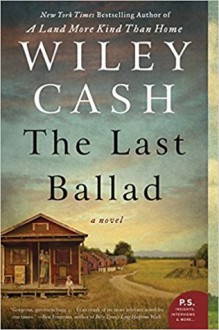
The Last Ballad, Wiley Cash
Wiley Cash has a way with words. He develops the characters so well that the reader walks alongside them as the book unfolds. living their experiences with them. This story has its base in the life of a real character, Ella May Wiggins, and coincidentally, Wiley Cash has relatives with the name, Wiggins, although they do not seem to be related.
This is the story of the very short and sad life of Ella May Wiggins. Once a hillbilly, she moved with her husband John to North Carolina to work in the mills. She lived in Stumptown, a small black community in which she was the only white resident. She, like them, was dirt poor. Her life has not been easy. Her husband walked out on her and she had recently thrown out the no account man who was also the father of the child growing in her belly. She was taking care of all her children by herself. The four of them walked barefoot and were often hungry. They looked after each other while she was at work at the local textile mill.
It is 1929 and Ella May worked at American Mill #2, owned and run by the Goldberg brothers. It was one of the few mills that was integrated. She was paid a paltry sum which barely put food on the table. When she was reprimanded for missing work because of a sick child, she decided to check out the textile worker’s union that was being organized by the Communist Party. Ella May lived from hand to mouth and was slowly growing desperate. At the union rally, encouraged by its organizers, she unexpectedly found herself singing her own songs and addressing the crowd. She was persuaded to join them in their effort to organize workers and to eventually take on a leadership role. She was also persuaded to try to integrate the union by encouraging her friends and neighbors to join her. It turned out to be a very dangerous endeavor. The world was not only anti-union and opposed to Communists, but integration of the unions was even more of a far-fetched effort.
The textile workers were engaged in a poorly organized strike when she became involved. It had not been very effective. She became the face and inspiration of the movement. At first there was very little violence, but as time passed, racism and anti-Communist sentiments aroused more violent passions.
The story of Ella May’s participation in the labor union struggle was related to her grandson Edwin by her daughter Lilly. It was the first time she was telling the whole story, about her mother’s brief life, to anyone at all. She was deep into her 80’s at the time she related this history to him. She had decided not to let the story of her mother’s heroism be forgotten.
Each of the novel’s chapters featured a different character. Each described the relationship of that character to Ella May and her struggles. I found the novel inspiring and informative. I had not known that the Communist Party was involved in our labor union struggles and movement. Actually, my experience with unions was quite negative for two reasons. One was that the striking workers forced my father out of his small business. He lost everything. Two was that I objected to the unionization of teachers, and I still do. Somehow it made me and them less professional and more demanding, not always for the benefit of the children or for the improvement of the schools, but more for the benefit of themselves. A combination of all ideals would have been more preferable, but sometimes the better goals are lost in the shuffle.
Still, the story makes the reader realize that unions were not only justified at one time, they were needed to level the playing field and provide better working conditions for all. The novel makes the reader very sympathetic to the plight of the overworked and abused employees, especially those of color who were not given any equality or respect. They were often humiliated by cruel white people, who felt superior to them, and today they still are in some places and in some circumstances. The danger, however, to me, is that the unions are subject to abuse because sometimes the members forget the purpose of the union, which is to improve conditions, and not necessarily to destroy a business, which is sometimes the ultimate end product when collective bargaining breaks down. A case in point is Stella D’oro.

 Log in with Facebook
Log in with Facebook 







